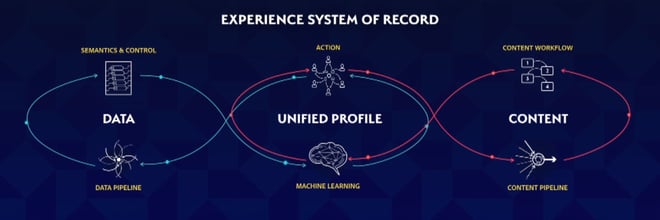In this day and age, companies and brands are encouraged to exceed customer expectations by delivering personalized experiences. Hence, it's about time you change the title on your business card into 'experience maker'. There are many definitions, but this one sums it up perfectly: “A true experience maker is only happy when the customer’s life is made a lot easier”. Or as CMO Claire Cronin stated during the Adobe Summit in May 2018: “At Virgin Atlantic, we are memory makers and the customer is the compass.”For example, Virgin's crew is empowered to create special customer experiences, not based on predefined scripts, but on their initiative and with their own creativity. Creating memories is linked to creating relevance for the customer, and the key to unlock this is data, the gold for marketers.
I hear you thinking, “This will demand a lot of effort and investment”, and it’s true. Yet research by Forrester shows us that those efforts and investments in becoming an experience maker (and the required marketing technology) will not be in vain: the factors of 1,4 more brand awareness or 1,5 higher average order value provide proof.

Human or AI?
So we need to create personalized customer experiences, but how? Most companies are faced with the fact that customers are always ahead of what they can digitally build. Or in other words: organizations are always lagging behind. On the one hand, the solution lies in key human elements that computers and Artificial Intelligence don’t possess (yet): creativity and empathy. We can put ourselves in the shoes of our customers, “feel” their pains, problems and needs and create great experiences. But every person is unique and has their own pains, problems and needs that need to be solved. This is where on the other hand data, Artificial Intelligence (AI) and a unified profile come into play. The unified profile contains all the data about one individual customer, created and enriched by the computational power of AI and machine learning.
The above visual displays Adobe’s 'Experience System of Record', which unifies your experience data, content and unified profile to provide extraordinary personalized customer experiences. You notice 2 reinforcing loops:
- The (blue) data loop: The data pipeline collects and centralizes all data. In today’s world we have massive amounts of data (e.g. the Adobe servers process over 3 million transactions a second) and the volume, velocity and variety of data are still increasing. The semantics & control block is the next step in this loop and makes something meaningful out of this raw data. Machine learning helps us to process these insights into real-time actions towards the customers. When the customer interacts, it generates again new data and we are back to the start of this data loop.
- The (pink) content loop: Data alone will not create great experiences, content will. And content has its own pipeline, where all the content goes into content workflows to trigger action. Machine learning is helping us, marketers, to increase the content velocity by doing things like tagging, image processing or image recognition.
Exploring the Artificial Intelligence cave
“The cave you fear to enter holds the treasure you seek” (a quote by Joseph Campbell, Professor of Literature, 1904-1984) is again very actual when it comes to Artificial Intelligence. At the 2018 Adobe Summit, Jeremy White, executive editor of Wired UK, shared some facts about AI that made me feel enthusiastic about the future, but frightened me at the same time. Here they are:
- AI has now a 69% accuracy in predicting which people in a hospital will die. The same accuracy as a human doctor.
- Alexa is at human parity in understanding what someone really means.
- In Hong Kong there is a hedge fund managed by an AI with a financial return of 25%.
- Tay was an experimental chatbot of Microsoft, who started randomly insulting people. Still nobody knows why.
- Facebook experimented to let an AI bot learn to negotiate by letting it analyze 6000 conversations. But in fact the bot learned to lie and deceive.
- When you ask a question to the bot Viv of Samsung, it doesn’t just do natural language processing or understanding. It writes a program to solve the problem that was put on the table.
AI will thus be an important addition to the toolkit of marketers. But it will not (yet) be able to compete with our own human creativity and empathy. The capabilities of AI is already impressive, although these systems are still learning and evolving. We need to handle them with care. For the time being AI is best used as a tool that assists us in decision making: it has huge analytical power and can suggest decisions, but the final call is still better made by a human.
An interesting Adobe example of AI: when you have created a video ad, you are able to know the performance of the ad amongst all of your audiences, even before it goes on air. That way you can tweak your ad spend according to the audiences with the most impact, or you can remaster the ad and check if it has more impact on underperforming audiences. In a fully automated way, the tool even lets you create, short versions (e.g. for Facebook or Instagram) that will have the biggest performance for that channel. Cool, isn’t it?
So now the choice is yours: will you also become an experience maker and provide your customers with personalized experiences? Are you willing to embrace AI in your marketing toolkit and combine it with your own human superpower?
If you're interested in learning more about AI, make sure to download our slide deck presenting 10 tools to inject AI into your marketing efforts.
References: Forrester




